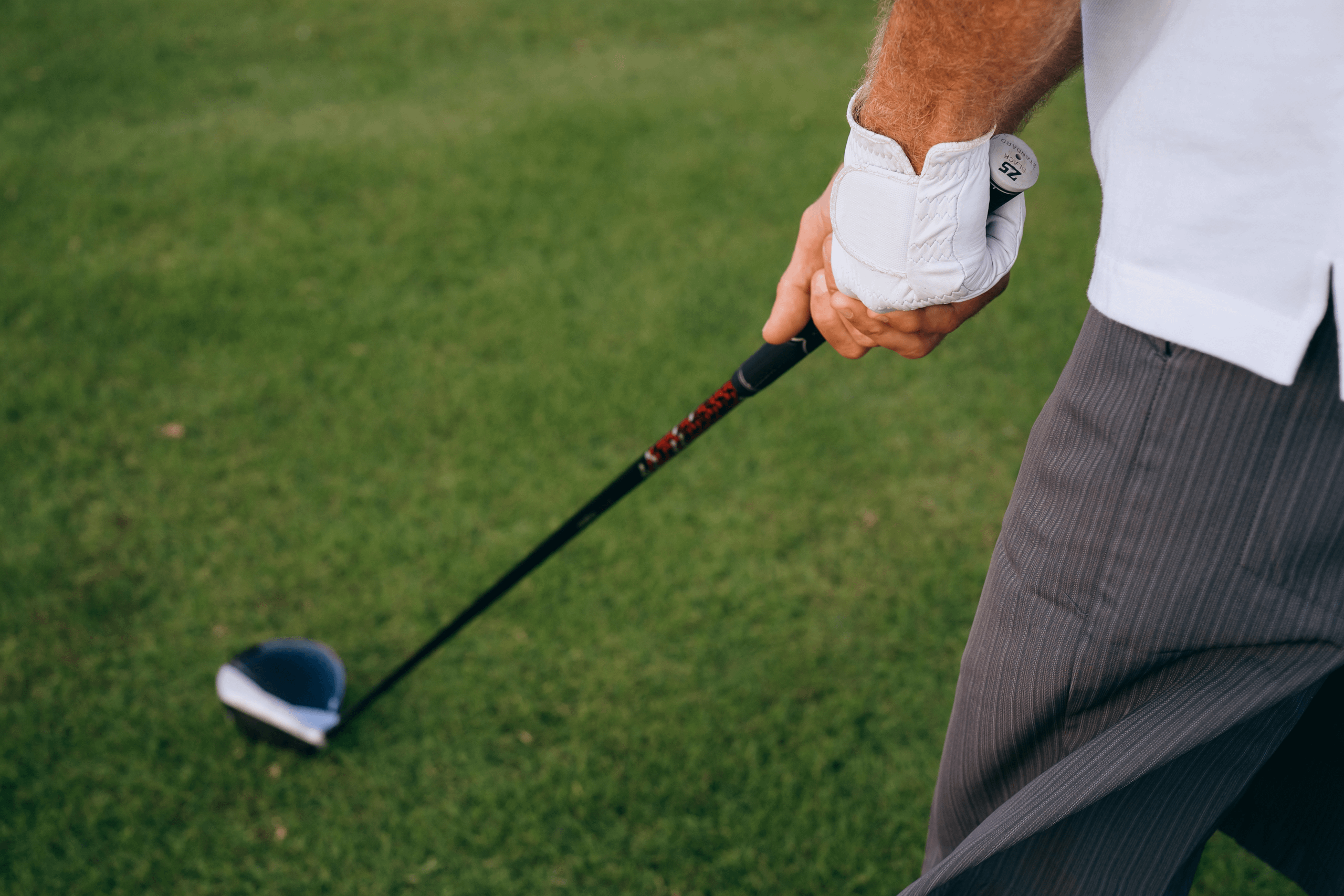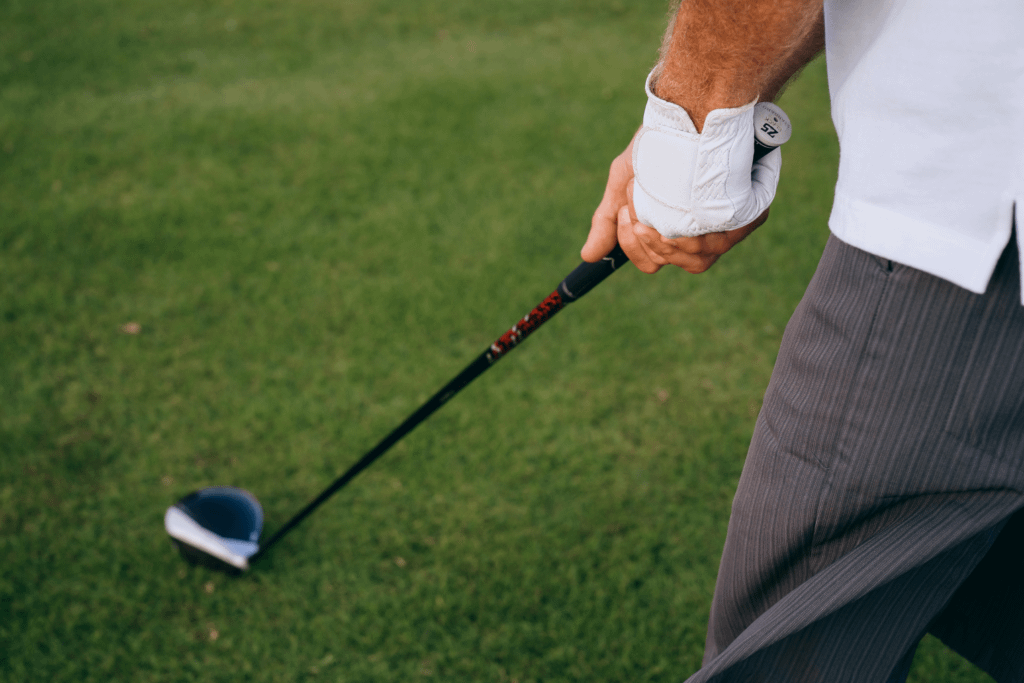
How to Hold A Golf Club Properly for Beginners

Correct Way to Hold a Golf Club
Holding a golf club may seem like a straightforward task, but in reality, it’s a fundamental skill that can significantly impact your golf ball and entire swing. A correct golf grip sets the stage for a fluid and powerful swing, enabling you to send the ball soaring down the fairway with accuracy and control. To achieve this, start by placing the club’s grip diagonally across the fingers of your top hand (left hand for right-handed golfers). The grip should rest primarily in your fingers rather than your palm, ensuring a secure yet relaxed hold. As your top hand wraps around the grip, allow your thumb to rest just slightly right of center, promoting a more neutral golf grip. Next, introduce your bottom hand, ensuring it fits snugly against your top thumb. Your thumbs should run straight down the grip’s top, forming a “V” shape between your thumbs and index fingers. The grip pressure should be firm enough to maintain control but not so tight that it restricts your wrist movement. Proper hand positioning establishes a solid foundation, allowing you to execute a balanced swing with a consistent clubface angle at impact. As you refine your grip through practice, you’ll uncover the delicate balance between tension and relaxation, ultimately leading to a swing that’s not only powerful but also refined and precise.
Types of Golf Grips
The grip forms the crucial connection between your body and the club, influencing the club face position at impact and the control you have over the ball’s trajectory. Try multiple grips to find the proper grip to fit your game.
Overlapping Golf Grip
The overlapping or “vardon” grip is one of the most popular and widely used grips in golf. This grip is created by positioning the pinky finger of one hand and placing it in the ridge between your other hand’s index and middle finger. This creates a firmer grip which can help increase control over the golf club during swings, resulting in more accuracy and consistency while driving.
The major advantage of this grip for golfers with particularly large hands is greater control. Having to squeeze the golf club tighter to make it easier to swing makes sense if you have larger hands as there’s more surface area to secure the handle against. With an overlapping grip, you won’t be able to torque as much compared to other grips but since you have a holding surface that’s larger than your hands, this full overlap grip will help you get better control over your clubs during shots. It also has zero chance of unintentional opening up while swinging, providing a consistent stroke angle throughout your shot.
Interlocking Grip
The interlocking golf club grip is a popular hand positioning technique that offers golfers a firm and connected grip on the club. In this grip, the little finger of the trailing hand is interlocked with the index finger of the lead hand. This overlapping of fingers creates a secure bond between the hands, promoting a unified swing and consistent control over the clubface. The interlocking grip can enhance the golfer’s ability to maintain a square clubface at impact, crucial for accurate shots. Many professional golfers, as well as amateurs, favor this grip due to its ability to provide a sense of unity and leverage in the swing. While it might take some practice to get used to, the interlocking golf grip grip can be a game-changer for those looking to optimize their hand positioning and overall swing mechanics, resulting in improved performance and confidence on the golf course.
10 Finger Grip
The ten finger grip, often referred to as the “full finger” or “baseball” grip, presents an alternative approach to hand positioning on the golf club. Unlike the overlapping or interlocking grips, the 10-finger grip involves placing all ten fingers directly on the club’s grip, forming a unified connection between your hands. This grip can be particularly appealing to beginners or individuals with hand or finger mobility issues, as it tends to feel more natural and comfortable. The 10-finger grip offers a sense of control and simplicity, allowing for a more straightforward motion during the swing. While it might not provide the same level of interconnectedness between the hands as other grips, it can still yield effective results when executed correctly. As with any grip, practice is key to refining your technique and finding the optimal hand positioning that suits your swing style and comfort. The 10-finger grip might just be the solution for golfers seeking an uncomplicated yet reliable grip that aids in consistent and enjoyable rounds on the course.
Grip Pressure: Finding the Sweet Spot
Maintaining the right amount of grip pressure is crucial for a successful golf swing. Gripping the club too tightly can restrict wrist movement and lead to tense, inaccurate shots. On the other hand, holding the club too loosely can result in a loss of control and power. The key is to find the “sweet spot” – a balance between firmness and relaxation. Additionally, a weak grip, where the hands are turned more toward the target, can influence the clubface’s angle at impact and lead to specific shot shapes, offering yet another aspect to consider. Apply slightly more pressure with your top hand (left hand for right hand) and let the bottom hand provide support. This balanced grip pressure enables your wrists to hinge naturally during the backswing and release smoothly through impact.
Hand Positioning on a Golf Club
Hand positioning on a golf club is a foundational element that can significantly influence your swing’s outcome. Getting it right is crucial for achieving both power and precision in your shots. When gripping the club, your hands act as the sole point of contact between your body and the club itself. To achieve an optimal hand positioning, start by placing the club’s grip diagonally across the base of your fingers. Your top hand, should grip the club first. The “V” formed by your thumb and index finger should point toward your rear shoulder. As for your bottom hand, the thumb should rest on top of the grip, aligning with the club’s shaft. This double-overlap or interlocking grip creates a unified connection between your hands, enhancing control and allowing for a smoother swing. Proper hand positioning not only aids in generating power and straight ball flight but also assists in maintaining a consistent clubface angle at impact. Remember, achieving the correct hand positioning might feel awkward initially, but with practice, it becomes second nature, paving the way for improved shots and overall performance on the course.
Tailoring Techniques for Left and Right Handers
When it comes to golf, the fundamentals lay the groundwork for a successful swing and game. One fundamental that stands out prominently is the grip – the foundation upon which your swing is built. While the basics of a good grip remain constant, there are subtle yet significant differences between left-handed and right-handed golfers.
Whether you’re a left-handed or right-handed golfer, remember that the key to a successful grip lies in finding a balance between control and comfort. Experiment with different grip pressures and hand placements to discover what feels most natural to you. Regardless of your dominant hand, a solid grip paves the way for a powerful and accurate swing, making it a crucial skill to master for golfers of all orientations.
Left Hand Grip
For left-handed golfers, the grip begins by placing the club’s grip diagonally across the fingers of the right hand. The fingers wrap around the grip, with the palm facing upwards and the thumb pointing slightly left of center. This initial positioning sets the foundation for a strong and controlled grip. As the left hand comes into play, it’s essential to create a harmonious connection between the two hands. The left hand, with the palm facing towards you, fits comfortably against the right thumb, establishing a seamless alignment between the hands. The left thumb rests on the grip, mirroring the placement of the right thumb on the opposite side.
Right Hand Grip
For right-handed golfers, achieving a solid grip is paramount to unlocking the full potential of their swing. The grip is established by thoughtfully placing the club’s grip diagonally across the fingers of the left hand, creating a sturdy foundation that serves as the cornerstone of a successful golf shot.
As the fingers wrap around the grip, a sense of connection and control begins to form. The grip should feel natural and comfortable, with the fingers securing the club without squeezing too tightly. This subtle balance ensures that the hands can work together seamlessly throughout the swing.
In tandem with the hand placement, the positioning of the thumb plays a crucial role in maintaining the grip dynamics and clubface alignment throughout the golf swing. The left thumb should align with the club’s shaft, pointing slightly right of center. This positioning sets the stage for a cohesive and harmonious grip that minimizes unwanted clubface rotation during impact.
As with any golf skill, practice and refinement are key. Investing time and effort into mastering the art of grip can yield substantial dividends during your next round.
Grip Alignment: The Clubface Connection
The alignment of your grip plays a pivotal role in determining the position of the clubface at impact. A square clubface at impact is essential for accurate shots. To achieve this, ensure that the “V” formed between your thumb and index finger on your top hand points towards your rear shoulder. This positioning encourages a neutral grip, preventing the clubface from being open or closed at impact. For the bottom hand, align the “V” similarly, making sure it mirrors the direction of the top hand’s “V.” Grip alignment plays a vital role in establishing a stable base for consistent and predictable ball flight.
Differences in Holding A Driver Vs A Putter
Holding a driver and a putter are two very different actions in the game of golf. The driver is most commonly used off the tee for long distance shots, while the putter is used to roll the ball on the green to get it close to or into the hole. To ensure maximum accuracy and consistency, golfers have to adjust their technique when switching from one club to another.
When holding a driver, the grip should be light but firm enough so that your wrists can freely swing through. Generally, a golfer grasps their left hand (for right-handers) at least an inch or two down from the top of the club handle and positions it slightly in front of their right hand. This stance allows for better control over long drives and more power off impact.
To properly hold a putter, both hands need to be low on either side of the grip with equal pressure from each hand applied throughout your stroke. Your arms should be extended in alignment with shoulders as you look down towards your feet. Keep your arms relaxed and connected with your body so that they remain parallel throughout your swing. It’s important that you don’t squeeze too tight or move your arms separately throughout
Final Thoughts
In the intricate world of golf, the foundation of mastery lies in holding a golf club. This skill resonates through every swing, from delicate grip pressure to various techniques like interlocking and 10-finger grips. Hand positioning orchestrates controlled movement, guiding shots with predictability. Regardless of your dominant hand, the grip unites golfers in pursuit of excellence. The grip is more than technical; it sparks swing magic, harmonizing every element into a symphony of motion. Armed with grip mastery, you wield the conductor’s baton, honoring the game’s legacy while carving your path to greatness. As you hold that club, remember the journey’s beginning—a world of endless possibilities on the green.
